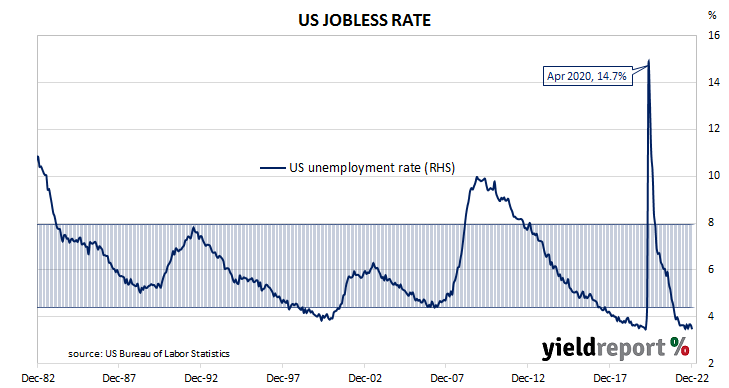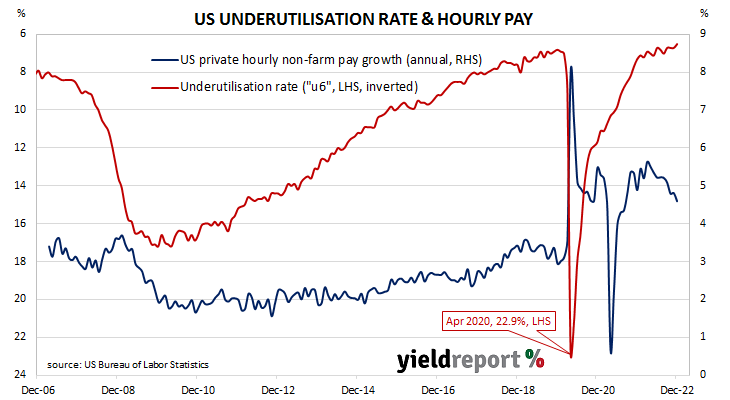Summary: Non-farm payrolls up 223,000 in November, greater than expected; previous two months’ figures revised down by 28,000; jobless rate declines to 3.5%, participation rate up; labour market report “solid”; employed-to-population ratio up; underutilisation rate down from 6.7% to 6.5%; annual hourly pay growth down from 4.8% to 4.6%; moderating wage growth “encouraging” for Fed.
The US economy ceased producing jobs in net terms as infection controls began to be implemented in March 2020. The unemployment rate had been around 3.5% but that changed as job losses began to surge through March and April of 2020. The May 2020 non-farm employment report represented a turning point and subsequent months provided substantial employment gains. Changes in recent months have been generally more modest but still above the average of the last decade.
According to the US Bureau of Labor Statistics, the US economy created an additional 223,000 jobs in the non-farm sector in December. The increase was greater than the 205,000 which had been generally expected but less than the 256,000 jobs which had been added in November after revisions. Employment figures for October and November were revised down by a total of 28,000.
The total number of unemployed dropped by 278,000 to 5.722 million while the total number of people who were either employed or looking for work increased by 439,000 to 164.966 million. These changes led to the US unemployment rate declining from October’s revised figure of 3.6% to 3.5% even as the participation rate ticked up from 62.2% to 62.3%.
“The December labour market report was solid, as labour demand remains robust,” said ANZ economist Gregorius Steven.
US Treasury yields fell noticeably on the day. By the close of business, the 2-year yield had shed 18bps to 4.28%, the 10-year yield had lost 16bps to 3.56% while the 30-year yield finished 9bps lower at 3.69%.
In terms of US Fed policy, expectations of higher federal funds rates over the next 12 months softened. At the close of business, contracts implied the effective federal funds rate would average 4.64% in February, 31bps higher than the current spot rate, and then climb to an average of 4.71% in March 2023. May 2023 futures contracts implied a 4.935% average effective federal funds rate while December 2023 contracts implied 4.57%.
One figure which is indicative of the “spare capacity” of the US employment market is the employment-to-population ratio. This ratio is simply the number of people in work divided by the total US population. It hit a cyclical-low of 58.2 in October 2010 before slowly recovering to just above 61% in late-2019. December’s reading kicked up from 59.9% to 60.1%, still some way from the April 2000 peak reading of 64.7%.
Apart from the unemployment rate, another measure of tightness in the labour market is the underutilisation rate and the latest reading of it registered 6.5%, down from 6.7% in November. Wage inflation and the underutilisation rate usually have an inverse relationship; however, hourly pay growth in the year to December slowed from 4.8% after revisions to 4.6%.
“Moderation in wage growth is encouraging for the Fed, but the numbers could be biased by strong growth in leisure and hospitality jobs, which are lower paid than average,” Steven noted.



